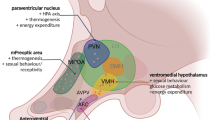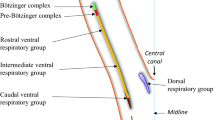Abstract
Nociceptin/orphanin FQ (N/OFQ) is the endogenous ligand for the N/OFQ peptide receptor (NOP) and has been shown previously to produce bradycardia and hypotension in rodents. In this study we have measured the effects of intravenous N/OFQ, and the NOP antagonists [Nphe1]N/OFQ(1–13)-NH2 ([Nphe1]) and [Nphe1,Arg14,Lys15]N/OFQ-NH2 (UFP-101) on cardiovascular parameters and plasma catecholamine concentrations. Female Hartley guinea pigs were anesthetized with pentobarbital and ventilated artificially. MAP and HR were measured via a femoral arterial catheter and ECG, respectively. Plasma catecholamine concentrations were measured by HPLC. Animals received saline, N/OFQ (0.25, 1.25, 6.25 and 25 nmol cumulatively at 10-min intervals), [Nphe1] (600 nmol) and UFP-101 (60 nmol) i.v. in various combinations. After establishing a stable baseline, MAP and HR measurements and blood sampling were performed at the beginning and 3 min following each drug administration. N/OFQ significantly decreased MAP, HR and the plasma noradrenaline concentrations in a dose dependent manner (maximally by 29.1±1.8%, 13.8±0.8% and 46.6±7.8%, respectively) To the contrary, N/OFQ tended to increase plasma adrenaline concentration but did not affect plasma dopamine concentrations. There was a significant correlation between percent change in MAP (0.69, P<0.01) or HR (0.84, P<0.01) and that in plasma noradrenaline. [Nphe1], but not UFP-101, alone significantly decreased MAP. [Nphe1] partially antagonized N/OFQ-induced hypotension, bradycardia and the decrease in plasma concentration of noradrenaline. UFP-101 fully prevented the effects of N/OFQ in this model. In conclusion, the present study shows that intravenous N/OFQ, via NOP receptors, elicits hypotension and bradycardia also in the anaesthetized guinea pig and that the decrease in MAP and HR are positively correlated with the decrease in the plasma noradrenaline level.



Similar content being viewed by others
References
Bucher B (1998) ORL1 receptor-mediated inhibition by N/OFQ of noradrenaline release from perivascular nerve endings of the rat tail artery. Naunyn-Schmiedebergs Arch Pharmacol 358:682–685
Calo' G, Guerrini R, Rizzi A, Salvadori S, Regoli D (2000a) Pharmacology of nociceptin and its receptor: a novel therapeutic target. Br J Pharmacol 129:1261–1283
Calo' G, Guerrini R, Bigoni R, Rizzi A, Marzola G, Okawa H, Bianchi C, Lambert DG, Salvadori S, Regoli D (2000b) Characterization of [Nphe(1)]N/OFQ(1–13)NH(2), a new selective N/OFQ receptor antagonist. Br J Pharmacol 129:1183–1193
Calo' G, Bigoni R, Rizzi A, Guerrini R, Salvadori S, Regoli D (2000c) Nociceptin/orphanin FQ receptor ligands. Peptides 21:935–947
Calo' G, Rizzi A, Rizzi D, Bigoni R, Guerrini R, Marzola G, Marti M, McDonald J, Morari M, Lambert DG, Salvadori S, Regoli D (2002) [Nphe1, Arg14, Lys15]Nociceptin-NH2, a novel potent and selective antagonist of the nociceptin/orphanin FQ receptor. Br J Pharmacol 136:303–311
Champion HC, Czapla MA, Kadowitz PJ (1997a) Nociceptin, an endogenous ligand for the ORL1 receptor, decrease cardiac output and total peripheral resistance in the rat. Peptides 18:729–732
Champion HC, Zadina JE, Kastin AJ, Hackler L, Ge LJ, Kadowitz PJ (1997b) Endomorphine 1 and 2, endogenous ligands for the μ-opioid receptor, decrease cardiac output, and total peripheral resistance in the rat. Peptides 18:1393–1397
Champion HC, Pierce RL, Kadowitz PJ (1998) Nociceptin, a novel endogenous ligand for the ORL1 receptor, dilates isolated resistance arteries from the rat. Regul Pept 78:69–74
Chen Y, Chang M, Wang ZZ, Chen LX, Yang Q, Wang R (2002) [Nphe1]nociceptin(1–13)-NH2 antagonizes nociceptin-induced hypotension, bradycardia and hindquarters vasodilation in the anesthetized rat. Can J Physiol Pharmacol 80:31–35
Chu X, Xu N, Li P, Mao L, Wang JQ (1999) Inhibition of cardiovascular activity following microinjection of novel opioid-like neuropeptide nociceptin (orphanin FQ) into the rat rostral ventrolateral medulla. Brain Res 829:134–142
Cox BM, Chavkin C, Christie MJ, Civelli O, Evans C, Hamon MD, Hoellt V, Kieffer B, Kitchen I, McKnight AT, Meunier JC, Portoghese P-S (2000) Opioid receptors. In: Girdlestone D (ed), The IUPHAR compendium of receptor characterization and classification. IUPHAR Media, London, pp 321–333
Dun NJ, Dun SL, Hwang LL (1997) Nociceptin-like immunoreactivity in autonomic nuclei of the rat spinal cord. Neurosci Lett 234:95–98
Giuliani S, Maggi CA (1996) Inhibition of tachykinin release from peripheral endings of sensory nerves by nociceptin, a novel opioid peptide. Br J Pharmacol 118:1567–1569
Giuliani S, Maggi CA (1997) Prejunctional modulation by nociceptin of nerve-mediated inotropic responses in guinea-pig left atrium. Eur J Pharmacol 332:231–236
Giuliani S, Tramontana M, Lecci A, Maggi CA (1997) Effect of N/OFQ on heart rate and blood pressure in anaesthetized rats. Eur J Pharmacol 333:177–179
Grisel JE, Mogil JS (2000) Effects of supraspinal orphanin FQ/nociceptin. Peptides 21:1037–1045
Guerrini R, Calo G, Rizzi A, Bianchi C, Lazarus LH, Salvadori S, Temussi PA, Regoli D (1997) Address and message sequences for the nociceptin receptor: a structure-activity study of nociceptin-(1–13)-peptide amide. J Med Chem 40:1789–1793
Ho M, Corbett AD, Mcknight AT (2000) Characterization of the ORL1 receptor on adrenergic nerves in the rat anococcygeus muscle. Br J Pharmacol 131:349–355
Jinsmaa Y, Takahashi M, Fukunaga H, Yoshikawa M (2000) Retro-nociceptin methylester, a peptide with analgesic and memory-enhancing activity. Life Sci 67:3095–3101
Kapusta DR (2000) Neurohumoral effects of orphanin FQ/nociceptin: relevance to cardiovascular and renal function. Peptides 21:1081–1099
Kapusta DR, Kenigs VA (1999) Cardiovascular and renal responses produced by central orphanin FQ/nociceptin occur independent of renal nerves. Am J Physiol 277:R987–995
Kapusta DR, Dayan LA, Kenigs VA (2002) Nociceptin/orphanin FQ modulates the cardiovascular, but not renal, responses to stress in spontaneously hypertensive rats. Clin Exp Pharmacol Physiol 29:254–259
Lai CC, Wu SY, Chen CT, Dun NJ (2000) Nociceptin inhibits rat sympathetic preganglionic neurons in situ and in vitro. Am J Physiol Regul Integr Comp Physiol 278:R592–R597
Madeddu P, Salis MB, Milia AF, Emanueli C, Guerrini R, Regoli D, Calo' G (1999) Cardiovascular effects of N/OFQ in unanesthetized mice. Hypertension 33:914–919
Malinowska B, Kozlowska H, Koneczny B, Schlicker E (2000) Nociceptin inhibits the neurogenic vasopressor response in the pithed rat via prejunctional ORL1 receptors. Naunyn-Schmiedebergs Arch Pharmacol 361:80–84
Malinowska B, Piszcz J, Koneczny B, Hryniewicz A, Schlicker E (2001) Modulation of the cardiac autonomic transmission of pithed rats by presynaptic opioid OP4 and cannabinoid CB1 receptors. Naunyn-Schmiedebergs Arch Pharmacol 364:233–241
Malinowska B, Godlewski G, Schlicker E (2002) Function of nociceptin and opioid OP4 receptors in the regulation of the cardiovascular system. J Physiol Pharmacol 53:301–324
Martin RJ, Bailey BA, Downer RG (1983) Rapid estimation of catecholamines, octopamine and 5-hydroxytryptamine in biological tissues using high-performance liquid chromatography with coulometric detection. J Chromatogr 278:265–274
Meunier JC (1997) Nociceptin/orphanin FQ and the opioid receptor-like ORL1 receptor. Eur J Pharmacol 340:1–15
Meunier JC, Mollereau C, Toll L, Suadeau C, Moisand C, Alvinerie P, Butour JL, Guillemot JC, Ferrara P, Monsarrat B, Mazarguil H, Vassart G, Permentier M, Constentin J (1995) Isolation and structure of the endogenous agonist of opioid receptor-like ORL1 receptor. Nature 377:532–535
Okawa H, Kudo M, Kudo T, Guerrini R, Lambert DG, Kushikata T, Yoshida H, Matsuki A (2001) Effects of nociceptinNH2 and [Nphe1]nociceptin(1–13)NH2 on rat brain noradrenaline release in vivo and in vitro. Neurosci Lett 303:173–176
Patel HJ, Giembycz MA, Spicuzza L, Barnes PJ, Belvisi MG (1997) Naloxone-insensitive inhibition of acetylcholine release from parasympathetic nerves innervating guinea-pig trachea by the novel opioid, nociceptin. Br J Pharmacol 120:735–736
Reinscheid RK, Nothacker HP, Bourson A, Ardati A, Henningsen RA, Bunzow JR, Grandy DK, Langen H, Monsma FJ Jr, Civelli O (1995) Orphanin FQ: a neuropeptide that activates an opioid like G protein-coupled receptor. Science 270:792–794
Salis MB, Emanueli C, Milia AF, Guerrini R, Madeddu P (2000) Studies of the cardiovascular effects of N/OFQ and related peptides. Peptides 21:985–993
Shirasaka T, Kunitake T, Kato K, Takasaki M, Kannan H (1999) Nociceptin modulates renal sympathetic nerve activity through a central action in conscious rats. Am J Physiol 277:R1025–1032
Tian JH, Xu W, Fang Y, Mogil JS, Grisel JE, Grandy DK, Han JS (1997) Bidirectional modulatory effect of orphanin FQ on morphine-induced analgesia: antagonism in brain and potentiation in spinal cord of the rat. Br J Pharmacol 120:676–680
Trendelenburg AU, Cox SL, Schelb V, Klebroff W, Khairallah L, Starke K (2000) Modulation of (3)H-noradrenaline release by presynaptic opioid, cannabinoid and bradykinin receptors and beta-adrenoceptors in mouse tissues. Br J Pharmacol 130:321–330
Yamada H, Nakamoto H, Suzuki Y, Ito T, Aisaka K (2002) Pharmacological profiles of a novel opioid receptor-like1 (ORL(1)) receptor antagonist, JTC-801. Br J Pharmacol 135:323–332
Yamazaki T, Akiyama T, Mori H (2001) Effects of nociceptin on cardiac norepinephrine and acetylcholine release evoked by ouabain. Brain Res 904:153–156
Acknowledgements
This work was supported by the grant provided by the Ichiro Kanehara foundation in Japan. The authors are grateful to Dr David G. Lambert for helpful discussion at Department of Anaesthesia, Critical Care and Pain Management, University of Leicester, UK.
Author information
Authors and Affiliations
Corresponding author
Rights and permissions
About this article
Cite this article
Hashiba, E., Hirota, K., Kudo, T. et al. Effects of nociceptin/orphanin FQ receptor ligands on blood pressure, heart rate, and plasma catecholamine concentrations in guinea pigs. Naunyn-Schmiedeberg's Arch Pharmacol 367, 342–347 (2003). https://doi.org/10.1007/s00210-003-0704-9
Received:
Accepted:
Published:
Issue Date:
DOI: https://doi.org/10.1007/s00210-003-0704-9




